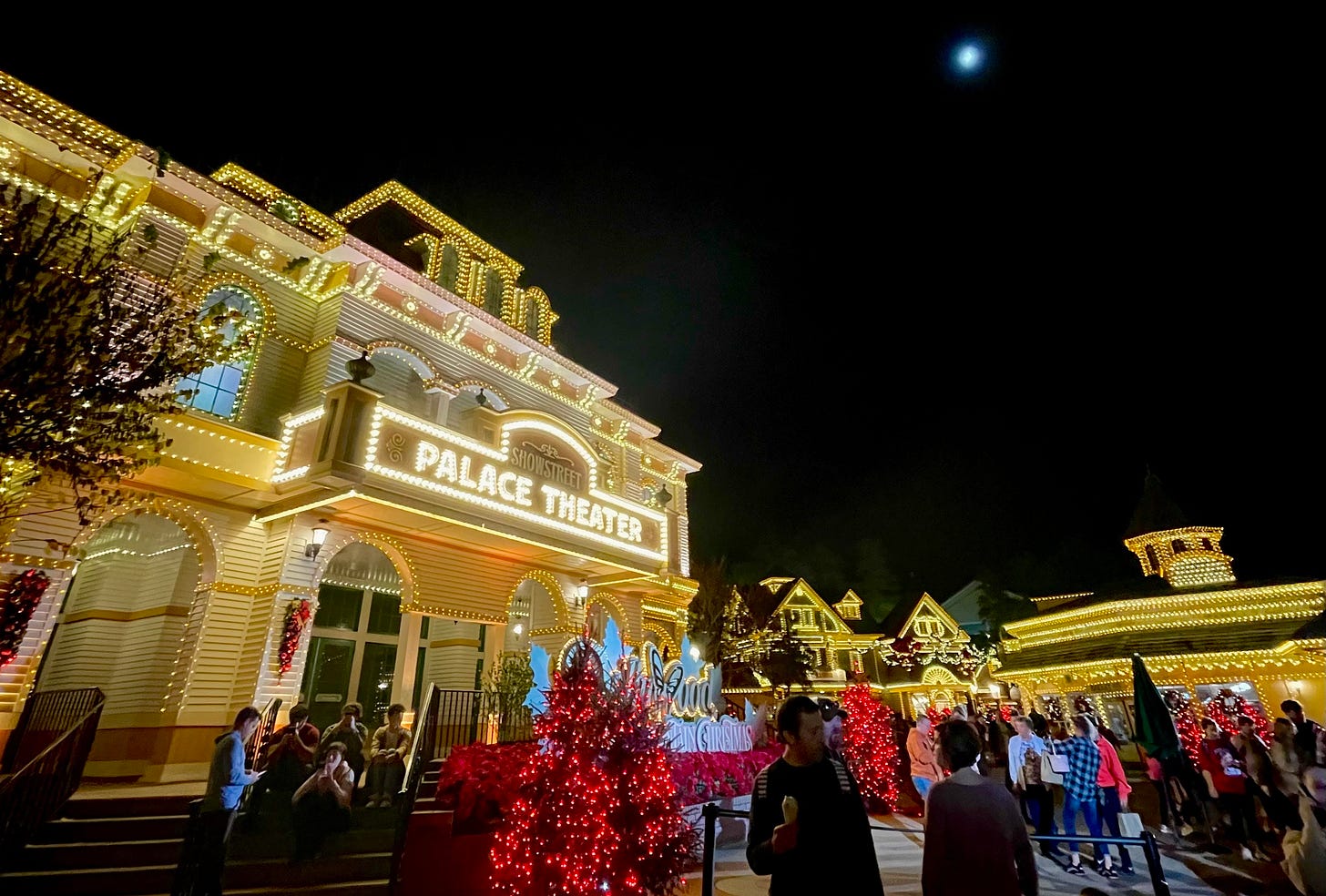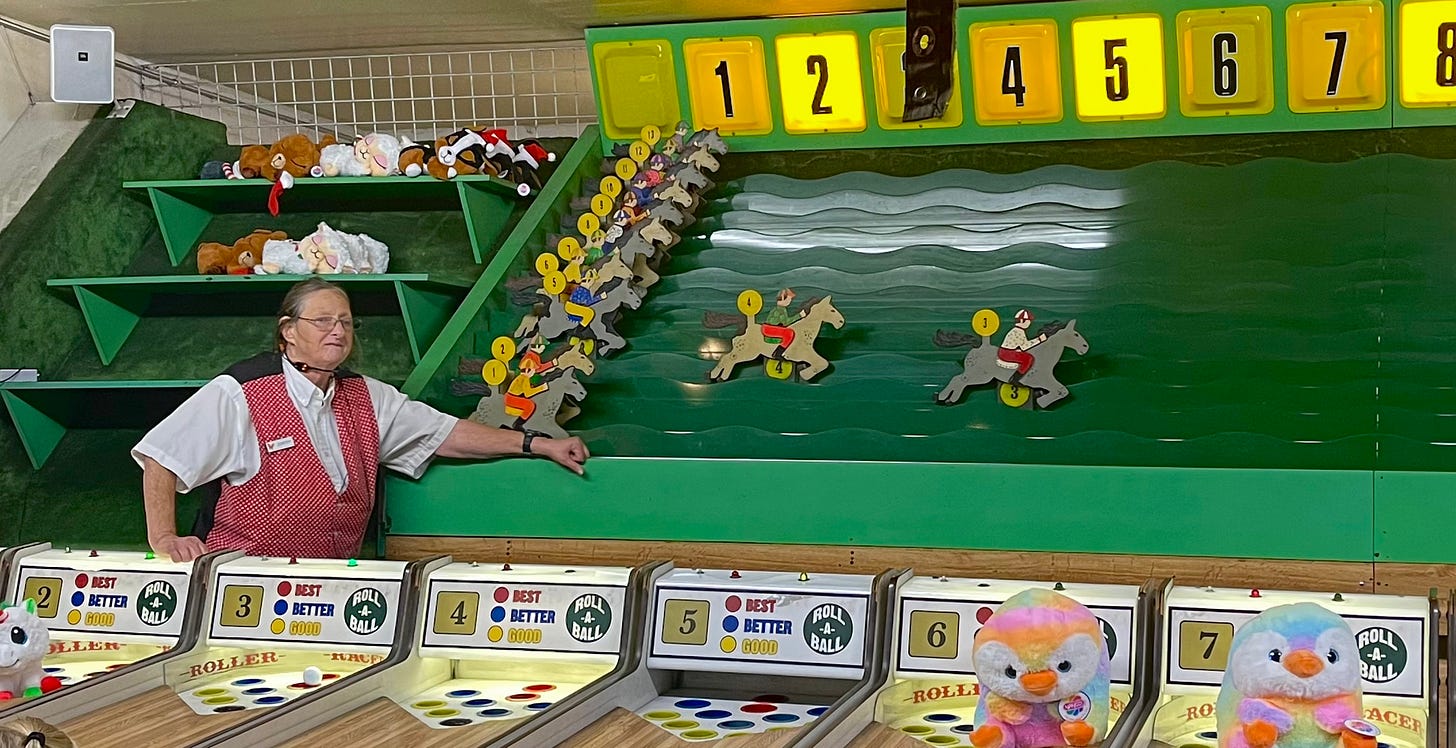Dolly Parton grew up collecting wild pokeberries. They’re poisonous to eat, but she and her sisters would mash the dark fruit into primitive makeup to color their cheeks berry-red. That’s why, when naming one of many paths that crisscross her theme park and resort in East Tennessee, she thought of ‘Pokeberry Lane.’
Dollywood is unlike other theme parks. It feels more like walking into somebody’s childhood memories, where everything feels a little more lush and romantic; from the authentic spinning wheel of the grist mill to the five-and-dime store facades that line the streets. Red’s Drive-In, where Dolly tasted her first “store-bought” hamburger, is replicated in the park just a short walk from the Pines Theater, where she gave her first public performance at age 10 in downtown Sevierville.
I visited in November, which is a slower month with discounted admission, but the park was still crowded. Among the masses I spotted West Virginia University hats and Steelers shirts, suggesting Dolly fans had traveled from distant corners of Appalachia. Rust belt signifiers blended in with typical Tennessee clothing: I found myself playing a game where I counted how many men wore something that referenced guns, Trump, the American flag, or the military. It was most of them.
My friends and I, in our garish and artsy outfits, must have stood out like a sore thumb. But in Dolly’s world, there’s a safety in looking ridiculous. All of us were there to celebrate a woman who built her career on an overdone appearance: “it takes a lot of time and money to look this cheap, honey.”
It’s hard to explain why, across political and generational divides, people here always seem to find peaceful ground when it comes to Dolly. At the auto shop last month, a man wearing what I can only describe as an “AR-15-themed outfit” gushed to me about the vanity plate on my car that featured her smiling face. She’s the closest thing we have to a sanctified figure in Tennessee.
Part of it might be explained by her philanthropy: with a net worth of half a billion, Dolly uses her wealth more like an old-school Andrew Carnegie-style capitalist than a modern Elon Musk. Like most kids in Tennessee, I grew up reading books from Dolly’s Imagination Library, which she sends for free to every child, every month. Nearly 30 years later, my cousins are now reading Dolly’s books to their toddlers.
Literacy is important to Dolly Parton because her own father never learned how to read. She was one of many children in a working-class family with no education, wealth, or connections to propel an aspiring starlet out of Sevierville. As I explored the ‘Dolly Parton Experience,’ a narrated museum tour of her life, I saw the tin can on a stick that she sang into as a young girl, performing for livestock in the family’s barn. I saw photos of Dolly’s rustic-looking parents, their faces gaunt and grim against the trees and sky, and I felt moved by her genuine rags-to-riches story.
There’s nothing more important to the American myth than a self-made millionaire. It’s one of the essential fantasies of living in this country. As I explored the park on Veteran’s Day, counting the images of guns, stars, and stripes that my fellow countrymen wore on their chests, I thought about the stories and pictures that help us create a national identity, for better or for worse.
When we visit Dollywood, we’re immersed in the myth of the white Appalachian homesteader: the plucky family struggling to make a decent life in a world of ham and beans, hand-crafts, and hollers. It’s the closest thing most Tennesseeans have to roots in this part of the South, where our Appalachian ancestors were either settlers themselves or descended from some.
The myth rarely mentions Native Americans, who were ethnically cleansed from the region on the Trail of Tears, or African Americans, who came to uphold the Southern economy through chattel slavery. If anyone could turn such bloody memories into something beautiful, it’s Dolly. She mashes them up like poisonous berries and paints a new picture.
As she tells it: “the beauty I saw in the Great Smoky Mountains as a child, I still see in the mountains season after season. When I close my eyes and listen closely to the sounds of nature, I am inspired by memories of my people and my Tennessee mountain home.”
Of course, I am also from Tennessee, so allow me a moment to get a little rosy about Dolly Parton myself. I think, if you also grew up in Appalachia, you understand exactly why Dolly is so caught up in that romantic connection to the mountains. I think a lot of us are inexplicably drawn to these green and blue ridges, that they call us home in a way that feels primal, that other parts of the Earth just don’t satisfy.
This might be the strongest thread that binds Dolly to her massive cult following here in her home state: the idea that she found her voice and achieved all that fame not in spite of Tennessee, but thanks to it. She didn’t escape Sevierville; rather, she brought it to the rest of the world.
Is Dolly Parton a Gramscian organic intellectual, bringing the struggle of her working-class origin with her as she infiltrates the halls of the bourgeoisie? I wouldn’t go that far. But I do think her mountain mythology has made working-class people in the South feel remembered and important, and her music has given us something to bond over as neighbors that isn’t a gesture toward fascism, as most cultural signifiers in Tennessee frankly are.
I ended my visit to Dollywood with a stop at Bucc-ee’s: perhaps the single most American itinerary you could plan for a day trip. My friends and I wove through racks of noxious-smelling polyester clothing and picked up brisket sandwiches—fresh brisket on the board!—to sustain us on the drive home. On the way back, we passed sex shops, helicopter tours, and dozens of billboards for an official Trump merch store. It’s disorienting to leave Dolly’s version of Tennessee and re-integrate into the real one.
Now that I’m back to Chattanooga, I’ve been thinking incessantly about my encounter with the Tennessee myth. As an artist, I wonder how I could go about intentionally shaping a new mythology; one that could somehow push back the creeping shadow of fascism that depends on its own myth-making projects for fuel and agitation. My best ideas feel toothless in the grand scheme of things—“we need more union bomber jackets!”—but that’s about all I have right now.
But if Dolly could build an entire world just by writing her songs in those mountains, maybe there is a way. All we can do is work to create worlds, one day at a time; working 9-to-5, as they say.
Labor Intensive Recommendations
The Beautiful Flower is the World — this book by Jerry Hsu inspired the photos I took at Dollywood, shout out to my friend Heath Creel for showing it to me.
Yawamushi Pedal — cute anime about bike racing.
Damnation — 1988 Hungarian movie with labor vibes.









Amazing, Tab. Just a brilliant account all around. Glad you had a Dollywood>Buc-ee’s adventure and appreciate your writing sooooo much. 👏👏👏👏